xarray powered Cf/Radial and ODIM_H5#
In this example, we read and write Cf/Radial (NetCDF) and ODIM_H5 (HDF5) data files from different sources using an xarray powered data structure.
Note
The following functionality is deprecated. Please use the xarray backend loaders instead.
[1]:
import wradlib as wrl
import warnings
warnings.filterwarnings("ignore")
import matplotlib.pyplot as pl
import numpy as np
import xarray as xr
try:
get_ipython().run_line_magic("matplotlib inline")
except:
pl.ion()
from wradlib.io.xarray_depr import CfRadial, OdimH5
import tempfile
/home/runner/micromamba-root/envs/wradlib-tests/lib/python3.11/site-packages/tqdm/auto.py:22: TqdmWarning: IProgress not found. Please update jupyter and ipywidgets. See https://ipywidgets.readthedocs.io/en/stable/user_install.html
from .autonotebook import tqdm as notebook_tqdm
Load ODIM_H5 Volume Data#
[2]:
fpath = "hdf5/knmi_polar_volume.h5"
f = wrl.util.get_wradlib_data_file(fpath)
cf1 = OdimH5(f, standard="cf", georef=True)
Inspect root group#
You can use the object dictionary using cf1[‘root’] or the property cf1.root.
The sweep dimension contains the number of scans in this radar volume. Further the dataset consists of variables (location coordinates, time_coverage) and attributes (Conventions, metadata).
[3]:
cf1.root
[3]:
<xarray.Dataset>
Dimensions: (sweep: 14)
Dimensions without coordinates: sweep
Data variables: (12/14)
volume_number int64 0
platform_type <U5 'fixed'
instrument_type <U5 'radar'
primary_axis <U6 'axis_z'
time_coverage_start <U20 '2011-06-10T11:40:02Z'
time_coverage_end <U20 '2011-06-10T11:43:54Z'
... ...
altitude float32 50.0
altitude_agl float64 nan
sweep_group_name (sweep) <U8 'sweep_1' 'sweep_2' ... 'sweep_14'
sweep_fixed_angle (sweep) float32 0.3 0.4 0.8 1.1 ... 12.0 15.0 20.0 25.0
frequency float64 nan
status_xml <U4 'None'
Attributes: (12/19)
Conventions: Cf/Radial
version: H5rad 2.0
title: None
institution: RAD:NL51;PLC:nldhl
references: None
source: None
... ...
ray_times_increase: "true" or "false", assumed "true" if missing. This ...
field_names: array of strings of field names present in this file.
time_coverage_start: copy of time_coverage_start global variable
time_coverage_end: copy of time_coverage_end global variable
simulated data: "true" or "false", assumed "false" if missing. data...
instrument: RAD:NL51;PLC:nldhlInspect sweep group(s)#
The sweep-groups can be accessed via their respective keys. The dimensions consist of range and time with added coordinates azimuth, elevation, range and time. There will be variables like radar moments (DBZH etc.) and sweep-dependend metadata (like fixed_angle, sweep_mode etc.).
[4]:
cf1["sweep_1"]
[4]:
<xarray.Dataset>
Dimensions: (time: 360, range: 320)
Coordinates: (12/14)
sweep_mode <U20 ...
latitude float32 ...
altitude float32 ...
longitude float32 ...
elevation (time) float32 ...
azimuth (time) float32 ...
... ...
z (time, range) float32 ...
gr (time, range) float32 ...
rays (time, range) float32 ...
bins (time, range) float32 ...
x (time, range) float32 ...
* time (time) datetime64[ns] 2011-06-10T11:40:06.694446592 ... 201...
Data variables:
DBZH (time, range) float32 ...
sweep_number int64 ...
follow_mode <U4 ...
prt_mode <U5 ...
fixed_angle float32 ...[5]:
cf1["sweep_1"].DBZH
[5]:
<xarray.DataArray 'DBZH' (time: 360, range: 320)>
[115200 values with dtype=float32]
Coordinates: (12/14)
sweep_mode <U20 ...
latitude float32 ...
altitude float32 ...
longitude float32 ...
elevation (time) float32 ...
azimuth (time) float32 ...
... ...
z (time, range) float32 ...
gr (time, range) float32 ...
rays (time, range) float32 ...
bins (time, range) float32 ...
x (time, range) float32 ...
* time (time) datetime64[ns] 2011-06-10T11:40:06.694446592 ... 2011-...
Attributes:
IMAGE_VERSION: 1.2
standard_name: radar_equivalent_reflectivity_factor_h
long_name: Equivalent reflectivity factor H
units: dBZPlotting#
[6]:
cf1["sweep_1"].DBZH.plot.pcolormesh(x="x", y="y")
pl.gca().set_aspect("equal")
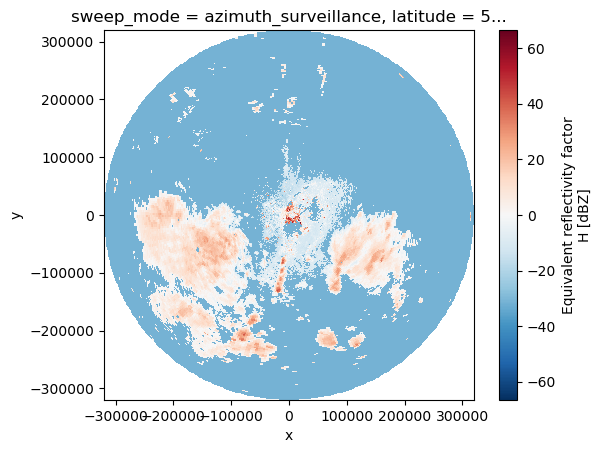
[7]:
fig = pl.figure(figsize=(10, 8))
cf1["sweep_1"].DBZH.sortby("azimuth").wradlib.plot_ppi(proj="cg", fig=fig)
[7]:
<matplotlib.collections.QuadMesh at 0x7fa438d37f90>

[8]:
import cartopy
import cartopy.crs as ccrs
import cartopy.feature as cfeature
map_trans = ccrs.AzimuthalEquidistant(
central_latitude=cf1["sweep_1"].latitude.values,
central_longitude=cf1["sweep_1"].longitude.values,
)
[9]:
map_proj = ccrs.AzimuthalEquidistant(
central_latitude=cf1["sweep_1"].latitude.values,
central_longitude=cf1["sweep_1"].longitude.values,
)
pm = cf1["sweep_1"].DBZH.wradlib.plot_ppi(proj=map_proj)
ax = pl.gca()
ax.gridlines(crs=map_proj)
print(ax)
< GeoAxes: +proj=aeqd +ellps=WGS84 +lon_0=4.7899699211120605 +lat_0=52.953338623046875 +x_0=0.0 +y_0=0.0 +no_defs +type=crs >

[10]:
map_proj = ccrs.Mercator(central_longitude=cf1["sweep_1"].longitude.values)
fig = pl.figure(figsize=(10, 8))
ax = fig.add_subplot(111, projection=map_proj)
pm = cf1["sweep_1"].DBZH.wradlib.plot_ppi(ax=ax)
ax.gridlines(draw_labels=True)
[10]:
<cartopy.mpl.gridliner.Gridliner at 0x7fa438addcd0>

[11]:
import cartopy.feature as cfeature
def plot_borders(ax):
borders = cfeature.NaturalEarthFeature(
category="physical", name="coastline", scale="10m", facecolor="none"
)
ax.add_feature(borders, edgecolor="black", lw=2, zorder=4)
map_proj = ccrs.Mercator(central_longitude=cf1["sweep_1"].longitude.values)
fig = pl.figure(figsize=(10, 8))
ax = fig.add_subplot(111, projection=map_proj)
DBZH = cf1["sweep_1"].DBZH
pm = DBZH.where(DBZH > 0).wradlib.plot_ppi(ax=ax)
plot_borders(ax)
ax.gridlines(draw_labels=True)
[11]:
<cartopy.mpl.gridliner.Gridliner at 0x7fa4389e5650>
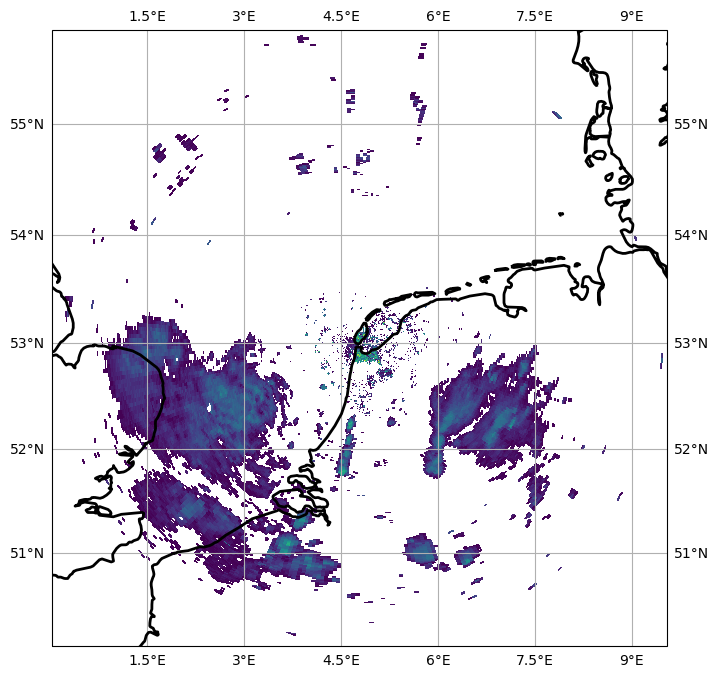
[12]:
import matplotlib.path as mpath
theta = np.linspace(0, 2 * np.pi, 100)
center, radius = [0.5, 0.5], 0.5
verts = np.vstack([np.sin(theta), np.cos(theta)]).T
circle = mpath.Path(verts * radius + center)
map_proj = ccrs.AzimuthalEquidistant(
central_latitude=cf1["sweep_1"].latitude.values,
central_longitude=cf1["sweep_1"].longitude.values,
)
fig = pl.figure(figsize=(10, 8))
ax = fig.add_subplot(111, projection=map_proj)
ax.set_boundary(circle, transform=ax.transAxes)
pm = cf1["sweep_1"].DBZH.wradlib.plot_ppi(proj=map_proj, ax=ax)
ax = pl.gca()
ax.gridlines(crs=map_proj)
[12]:
<cartopy.mpl.gridliner.Gridliner at 0x7fa438a52c10>
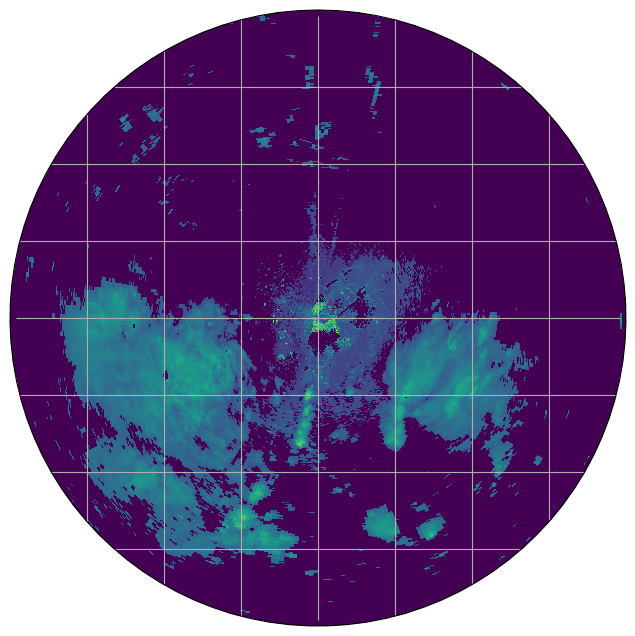
[13]:
fig = pl.figure(figsize=(10, 8))
proj = ccrs.AzimuthalEquidistant(
central_latitude=cf1["sweep_1"].latitude.values,
central_longitude=cf1["sweep_1"].longitude.values,
)
ax = fig.add_subplot(111, projection=proj)
pm = cf1["sweep_1"].DBZH.wradlib.plot_ppi(ax=ax)
ax.gridlines()
[13]:
<cartopy.mpl.gridliner.Gridliner at 0x7fa438b4c510>

[14]:
dbz = cf1["sweep_1"]
dbz.DBZH.wradlib.plot_ppi()
[14]:
<matplotlib.collections.QuadMesh at 0x7fa438d9f990>

Inspect radar moments#
The dataarrays can be accessed by key or by attribute. Each dataarray has the datasets dimensions and coordinates of it’s parent dataset. There are attributes connected which are defined by Cf/Radial and/or ODIM_H5 standard.
[15]:
cf1["sweep_1"].DBZH
[15]:
<xarray.DataArray 'DBZH' (time: 360, range: 320)>
[115200 values with dtype=float32]
Coordinates: (12/14)
sweep_mode <U20 ...
latitude float32 ...
altitude float32 ...
longitude float32 ...
elevation (time) float32 ...
azimuth (time) float32 ...
... ...
z (time, range) float32 ...
gr (time, range) float32 ...
rays (time, range) float32 ...
bins (time, range) float32 ...
x (time, range) float32 ...
* time (time) datetime64[ns] 2011-06-10T11:40:06.694446592 ... 2011-...
Attributes:
IMAGE_VERSION: 1.2
standard_name: radar_equivalent_reflectivity_factor_h
long_name: Equivalent reflectivity factor H
units: dBZ[16]:
cf1["sweep_1"]
[16]:
<xarray.Dataset>
Dimensions: (time: 360, range: 320)
Coordinates: (12/14)
sweep_mode <U20 ...
latitude float32 ...
altitude float32 ...
longitude float32 ...
elevation (time) float32 ...
azimuth (time) float32 ...
... ...
z (time, range) float32 ...
gr (time, range) float32 ...
rays (time, range) float32 ...
bins (time, range) float32 ...
x (time, range) float32 ...
* time (time) datetime64[ns] 2011-06-10T11:40:06.694446592 ... 201...
Data variables:
DBZH (time, range) float32 ...
sweep_number int64 ...
follow_mode <U4 ...
prt_mode <U5 ...
fixed_angle float32 ...Create simple plot#
Using xarray features a simple plot can be created like this. Note the sortby('time') method, which sorts the radials by time.
[17]:
cf1["sweep_1"].DBZH.copy().sortby("time").plot(add_labels=False)
[17]:
<matplotlib.collections.QuadMesh at 0x7fa438aab110>
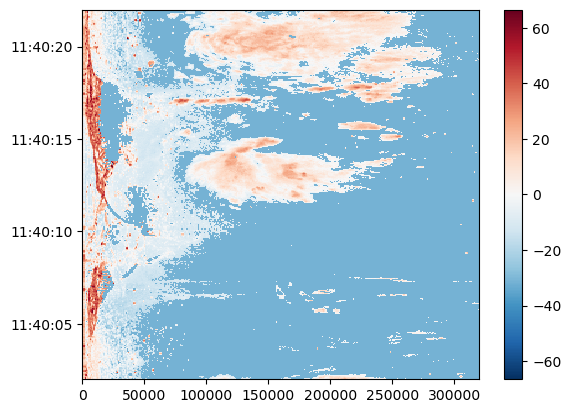
[18]:
pm = cf1["sweep_1"].DBZH.wradlib.plot_ppi(proj={"latmin": 33e3})
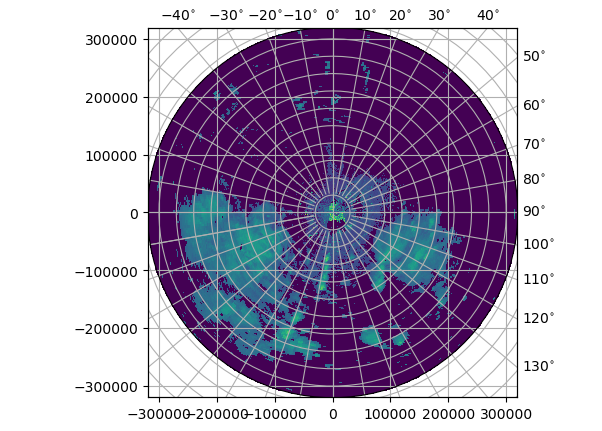
[19]:
h5_tempfile = tempfile.NamedTemporaryFile(suffix=".h5").name
nc_tempfile = tempfile.NamedTemporaryFile(suffix=".nc").name
cf1.to_odim(h5_tempfile)
cf1.to_cfradial2(nc_tempfile)
Import again#
[20]:
cf1a = OdimH5(h5_tempfile, standard="cf", georef=True)
cf1b = CfRadial(nc_tempfile, georef=True)
[21]:
cf1a["sweep_1"]
[21]:
<xarray.Dataset>
Dimensions: (time: 360, range: 320)
Coordinates: (12/14)
sweep_mode <U20 ...
latitude float32 ...
altitude float32 ...
longitude float32 ...
elevation (time) float32 ...
azimuth (time) float32 ...
... ...
z (time, range) float32 ...
gr (time, range) float32 ...
rays (time, range) float32 ...
bins (time, range) float32 ...
x (time, range) float32 ...
* time (time) datetime64[ns] 2011-06-10T11:40:06.694446592 ... 201...
Data variables:
DBZH (time, range) float32 ...
sweep_number int64 ...
follow_mode <U4 ...
prt_mode <U5 ...
fixed_angle float32 ...Check equality#
[22]:
xr.testing.assert_equal(cf1.root, cf1a.root)
xr.testing.assert_equal(cf1["sweep_1"], cf1a["sweep_1"].sortby("azimuth"))
xr.testing.assert_equal(cf1.root, cf1b.root)
xr.testing.assert_allclose(cf1["sweep_1"], cf1b["sweep_1"].sortby("azimuth"))
Mask some values#
[23]:
cf1["sweep_1"]["DBZH"] = cf1["sweep_1"]["DBZH"].where(cf1["sweep_1"]["DBZH"] >= 0)
cf1["sweep_1"]["DBZH"].sortby("time").plot()
[23]:
<matplotlib.collections.QuadMesh at 0x7fa442118110>
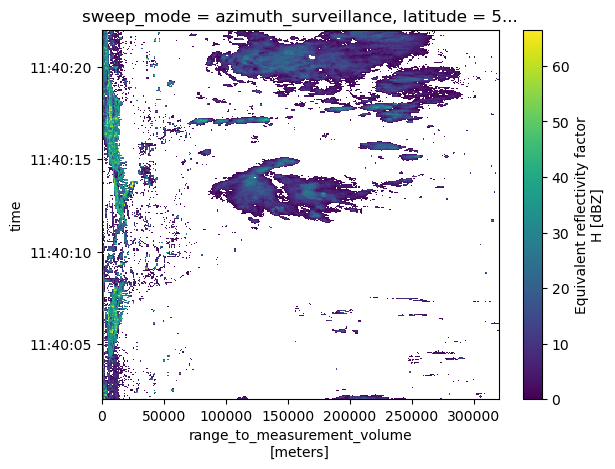
Load Cf/Radial1 Volume Data#
[24]:
fpath = "netcdf/cfrad.20080604_002217_000_SPOL_v36_SUR.nc"
f = wrl.util.get_wradlib_data_file(fpath)
cf2 = CfRadial(f) # , georef=True)
Fix duplicate rays#
[25]:
for i, key in enumerate(cf2):
num_rays = int(360 // cf2[key].azimuth.diff("time").median())
start_rays = cf2[key].dims["time"] - num_rays
cf2[key] = (
cf2[key].sortby("time").isel(time=slice(start_rays, start_rays + num_rays))
)
Inspect root group#
[26]:
cf2.root
[26]:
<xarray.Dataset>
Dimensions: (sweep: 9)
Dimensions without coordinates: sweep
Data variables:
volume_number int32 ...
platform_type |S32 ...
primary_axis |S32 ...
status_xml |S1 ...
instrument_type |S32 ...
time_coverage_start |S32 ...
time_coverage_end |S32 ...
latitude float64 ...
longitude float64 ...
altitude float64 ...
sweep_fixed_angle (sweep) float32 ...
sweep_group_name (sweep) <U7 'sweep_1' 'sweep_2' ... 'sweep_8' 'sweep_9'
Attributes: (12/14)
Conventions: CF/Radial instrument_parameters radar_parameters rad...
version: 1.2
title: TIMREX
institution:
references:
source:
... ...
instrument_name: SPOLRVP8
site_name:
scan_name:
scan_id: 0
platform_is_mobile: false
n_gates_vary: falseInspect sweep group(s)#
[27]:
cf2["sweep_1"]
[27]:
<xarray.Dataset>
Dimensions: (time: 480, range: 996)
Coordinates:
sweep_mode <U20 'azimuth_surveillance'
* time (time) datetime64[ns] 2008-06-04T00:15:03 ... 2008-06...
* range (range) float32 150.0 300.0 ... 1.492e+05 1.494e+05
azimuth (time) float32 ...
elevation (time) float32 ...
longitude float64 ...
latitude float64 ...
altitude float64 ...
Data variables: (12/16)
sweep_number int32 ...
polarization_mode |S32 ...
prt_mode |S32 ...
follow_mode |S32 ...
fixed_angle float32 ...
target_scan_rate float32 ...
... ...
antenna_transition (time) int8 ...
n_samples (time) int32 ...
r_calib_index (time) int8 ...
scan_rate (time) float32 ...
DBZ (time, range) float32 ...
VR (time, range) float32 ...Inspect radar moments#
[28]:
cf2["sweep_1"].DBZ
[28]:
<xarray.DataArray 'DBZ' (time: 480, range: 996)>
[478080 values with dtype=float32]
Coordinates:
sweep_mode <U20 'azimuth_surveillance'
* time (time) datetime64[ns] 2008-06-04T00:15:03 ... 2008-06-04T00:1...
* range (range) float32 150.0 300.0 450.0 ... 1.492e+05 1.494e+05
azimuth (time) float32 ...
elevation (time) float32 ...
longitude float64 ...
latitude float64 ...
altitude float64 ...
Attributes:
long_name: Computed Horizontal Co-polar Reflectivit
standard_name: equivalent_reflectivity_factor
units: dBZ
threshold_field_name:
threshold_value: -9999.0
sampling_ratio: 1.0
grid_mapping: grid_mappingCreate simple plot#
[29]:
cf2["sweep_1"].DBZ.plot()
[29]:
<matplotlib.collections.QuadMesh at 0x7fa431ff8110>

[30]:
cf2["sweep_1"].DBZ.pipe(wrl.georef.georeference_dataset).plot.pcolormesh(
x="x", y="y", add_labels=False
)
pl.gca().set_aspect("equal")
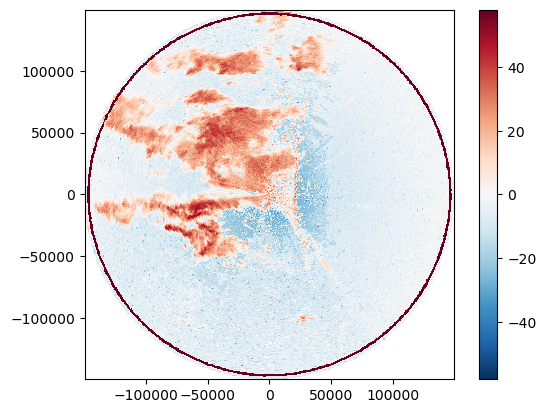
Use wradlib DataArray connector#
[31]:
pm = cf2["sweep_1"].DBZ.pipe(wrl.georef.georeference_dataset).wradlib.plot_ppi()
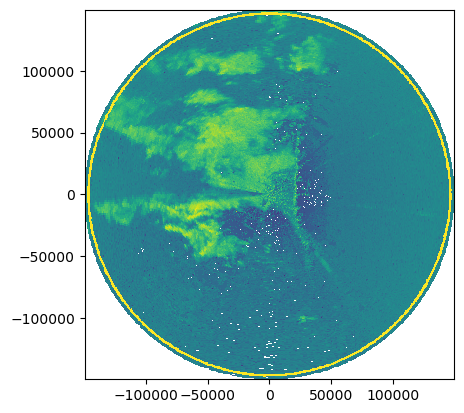
[32]:
pm = (
cf2["sweep_1"].DBZ.pipe(wrl.georef.georeference_dataset).wradlib.plot_ppi(proj="cg")
)
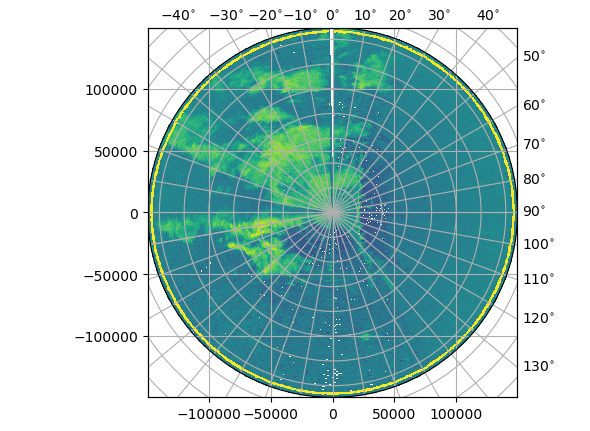
Export data to Cf/Radial2 and ODIM_H5#
[33]:
h5_tempfile = tempfile.NamedTemporaryFile(suffix=".h5").name
nc_tempfile = tempfile.NamedTemporaryFile(suffix=".nc").name
cf2.to_cfradial2(nc_tempfile)
cf2.to_odim(h5_tempfile)
[34]:
cf2["sweep_1"]
[34]:
<xarray.Dataset>
Dimensions: (time: 480, range: 996)
Coordinates:
sweep_mode <U20 'azimuth_surveillance'
* time (time) datetime64[ns] 2008-06-04T00:15:03 ... 2008-06...
* range (range) float32 150.0 300.0 ... 1.492e+05 1.494e+05
azimuth (time) float32 123.0 123.8 124.5 ... 120.8 121.5 122.2
elevation (time) float32 0.1648 0.1648 0.2142 ... 0.5109 0.5109
longitude float64 120.4
latitude float64 22.53
altitude float64 45.0
Data variables: (12/16)
sweep_number int32 0
polarization_mode |S32 b'not_set'
prt_mode |S32 b'not_set'
follow_mode |S32 b'not_set'
fixed_angle float32 0.4999
target_scan_rate float32 -9.999e+03
... ...
antenna_transition (time) int8 0 0 0 0 0 0 0 0 0 0 ... 0 0 0 0 0 0 0 0 0 0
n_samples (time) int32 192 192 192 192 192 ... 192 192 192 192 192
r_calib_index (time) int8 -1 -1 -1 -1 -1 -1 -1 ... -1 -1 -1 -1 -1 -1
scan_rate (time) float32 -3.277e+04 -3.277e+04 ... -3.277e+04
DBZ (time, range) float32 -6.079 10.45 ... -2.259 0.4694
VR (time, range) float32 26.71 24.83 ... -20.84 17.25Import again#
[35]:
cf2a = CfRadial(nc_tempfile)
cf2b = OdimH5(h5_tempfile, standard="cf")
[36]:
cf2a["sweep_1"].DBZ.pipe(wrl.georef.georeference_dataset).plot.pcolormesh(
x="x", y="y", add_labels=False
)
pl.gca().set_aspect("equal")
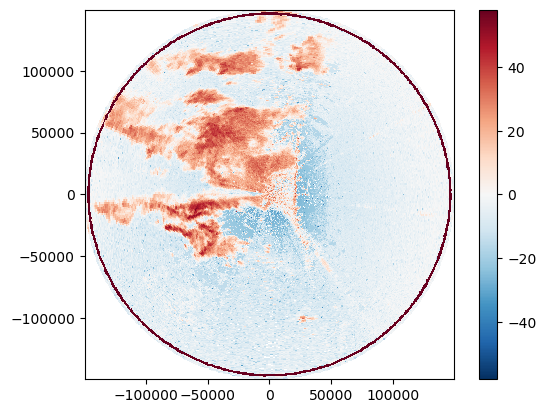
[37]:
cf2b["sweep_1"].DBZ.pipe(wrl.georef.georeference_dataset).plot.pcolormesh(
x="x", y="y", add_labels=False
)
pl.gca().set_aspect("equal")
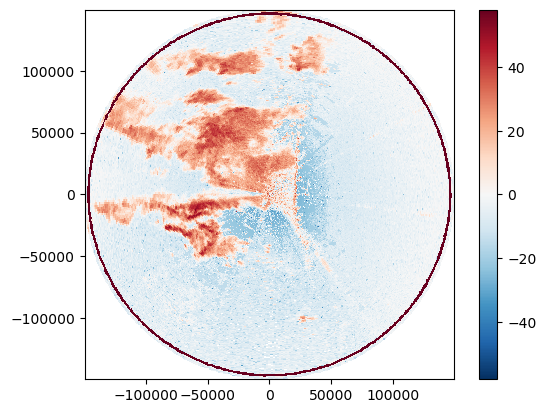
Check equality#
For Cf/Radial there are issues with nan, which need to be fixed. For the ODIM_H5 intercomparison there are too problems with nan and issues with attributes.
[38]:
xr.testing.assert_equal(cf2.root, cf2a.root)
xr.testing.assert_allclose(cf2["sweep_1"], cf2a["sweep_1"])
xr.testing.assert_allclose(
cf2.root.drop_vars(["volume_number", "status_xml"]),
cf2b.root.drop_vars(["volume_number", "status_xml", "altitude_agl", "frequency"]),
)
drop = set(cf2["sweep_1"]) ^ set(cf2b["sweep_1"]) | set(
["prt_mode", "follow_mode", "time"]
)
xr.testing.assert_allclose(
cf2["sweep_1"].drop_vars(drop).sortby("azimuth"),
cf2b["sweep_1"].drop_vars(drop, errors="ignore").sortby("azimuth"),
)
